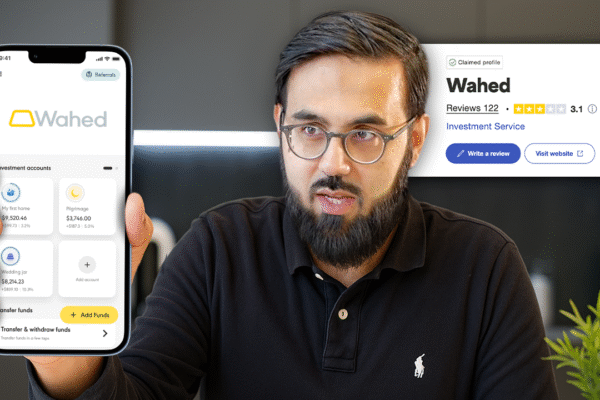
Is the S&P 500 Halal? A Guide for Muslim Investors
26 August 2025 7 min read


Ibrahim Khan
Co-founder
12 min read
Last updated on:
At Islamic Finance Guru, around 20% of our audience is based in the United States. Many of you have asked us to properly cover the halal investment options available in the USA. In this guide, we have picked through the investment options, the tax issues, the alphabet soup of pension vehicles, and considered the Islamic aspects.
If you're new to investing you may want to read this halal investing for beginners article or take our short video course before coming back to this.
Stocks and shares form the basis of most portfolios. The reason is because stocks and shares allow you to invest across a diverse range of an economy. From healthcare, to tech, to logistics. Stocks, therefore, unlike other assets, are very different to each other in terms of their risk profile.
There are two main ways in which you can invest in stocks:
Within option (2) there are two routes as well. You can get a cheap roboadvisor solution that gives you prepackaged portfolios or you can go for a more expensive individualised advice solution and get your own bespoke portfolio created suited to your wealth, needs, and risk appetite.
There has been a massive price war in the USA which has mean that trade fees are now $0 for a whole range of stockbrokers. In the UK we are still paying up to £10 per stock trade so this makes me cry a little bit inside. Take advantage of this guys!
Large brokerage houses include Charles Schwab, TD Ameritrade and Fidelity. Then you have a whole bunch of newcomers too, including Robinhood, M1 Finance* and others. The advantage of the newcomers is they typically have more user-friendly and slicker interfaces so you can buy and sell quickly and easily.
So you have a nice shiny broker account set up. Now what?
Now, you do the following:
DIY Investing is right for some people, but many people just want to give their money to someone who is an expert in this area and let them manage it for them. For Muslims there are two main routes to go down in the USA:
Wahed is the big sharia-compliant roboadvisor globally. It originated in the USA and its offering there is its cheapest and most mature offering. We have done detailed review of their offering here.
In short they are a great option if you really don’t want the hassle of doing any research into stocks and shares and investing (and even reading this far into an article like this one has broken you out into a sweat).
They will charge you 0.49% plus a monthly fixed fee of $5 if you invest less than $100,000 and just 0.49% if you invest $100,000 and more.
They also have FTSE USA Sharia ETF (otherwise known as HLAL) which is one of a few halal index ETFs currently available in the USA. You can buy this via your online broker (you don’t have to go via Wahed). What this means is that if you buy this “fund” you are essentially invested a little bit across the entire range of the US market (but only the halal stocks).
Index funds are great because they’re super diversified and basically just track the market. Over time they tend to perform as well as (if not better than) managed funds.
Having said all that, the Wahed Index ETF is really only relevant for you if you are going down the DIY route – as you won’t want to put all your wealth into this ETF. You want exposure to other asset classes (such a sukuk, property, global equities) which this ETF won’t give you.
ShariaPortfolio is also another option. They offer a roboadvisory solution starting at a minimum investment of $1000. Their website says that they offer a flat management fee “which ranges between 0.40 percent to 1.50 percent per year, depending on the amount of assets being managed and the type of service provided.”
They don’t charge on a per-trade basis.
They also offer the standard range of various tax-wrappers on their website:
I would definitely explore this option more carefully, but I suspect, for most people, the Wahed experience is smoother and cheaper as roboadvisory isn’t a focus for ShariaPortfolio like it is for Wahed. More on ShariaPortfolio below.
However do note that Sharia Portfolio also offer their own 2 sharia-compliant ETFs: The SP Funds S&P 500 Sharia Industry Exclusions ETF and the SP Funds Dow Jones Global Sukuk ETF. This is a great addition to the halal ETF market.
A new ETF that has also joined the mix is Falah Russell-IdealRatings U.S. Large Cap ETF (FIA). This is the Islamic version of the Russell 1000 index. It is another US-stock-focused ETF.
You can compare between all these ETFs and products on our investment comparison engine here.
Then you have the advised or managed funds. The difference between these guys and the index/tracker ETFs we were just discussing, is that these guys actually actively manage their funds and pick stocks that they think will do well rather than just passively track the stock market.
Amana Funds is the most well-known and established Islamic fund range available in the USA today. It offers four main funds which you can choose between depending on your risk appetite, aims and time horizons. You can buy these funds via your stockbroker. You don’t need to go through Amana for this. You can buy these funds through M1 Finance* and other large brokers.
They charge fees of between 0.88%-1.31% annually.
Azzad Funds is similar to Amana. They have 2 mutual funds which you can invest in via a stockbroker. They also offer 9 separately managed accounts that you can invest into via their “wrap program” which has a minimum investment of $500,000. The Azzad products are mainstream fund strategies run by mainstream fund managers, but with Azzad’s sharia screen tool reducing down the mainstream fund’s choices and getting rid of the impermissible stocks.
Iman Funds is similar to Amana and Azzad in that it too offers a mutual fund product that is purchasable through your stockbroker.
ShariaPortfolio does a few things. First, they offer their own ETFs and roboadvisory option as discussed above. Second, they offer bespoke portfolio management advice (which they get paid for through charging an advice fee rather than commission on any sale), and third they have some B2B type products for employers and financial advisors too.
For someone looking for bespoke financial advice, these guys look like the best option available in the USA right now. But if you’re happy to crack on without the advice, you can choose from any or all of the funds listed above.
You can compare between all these funds, their returns and fees on our investment comparison engine here.
From an initial look into this space, it appears that halal property investment opportunities are not that well-developed in the USA.
Bena Capital seems like a very interesting company – though it appears to be targeted at the more affluent end of the investor spectrum. It has previously raised multimillion dollar funds but is not currently taking on further capital.
Cur8 Capital recently launched its USD Income Fund. This fund invests in fully Sharia-compliant, asset-backed financing and leasing facilities, providing steady, stable, and relatively low-risk returns with a clear exit path.
Another option is to go for Real Estate Investment trusts. These are publicly traded companies that invest in property and pass dividends back to their investors. Typically though, many REITs will use haram debt to finance their portfolio. But there are a few ways you can get into REITS:
The other option to get into property investing is to DIY it. You can buy your own property, either in cash or by using a halal financing option (here is one I found from an initial search) and then rent it out, or fix it up and sell it on. Do subscribe to our website as we will be doing a lot more coverage of this investment area in coming months inshAllah.
On our halal investment comparison engine we have a bunch of investment options that are available to a global audience.
There are some that are specific to certain countries, e.g. Sarwa is specific to the UAE, however most of the companies listed on there accept overseas (including USA and Canada) investors. Here are some of the options available that definitely cater for American investors (and we have heard good feedback from our American investors on people who have used them):
You can invest abroad as an American and many people successfully do so. A few things to note though:
There is an absolute myriad of investment acronyms that are thrown around in the USA. Here is a quick hit list to demystify the main ones for you.
An individual retirement account (IRA) is a tax-beneficial investment pot designed to save for retirement. Your money avoids tax on the way in, but it is taxed on the way out.
There’s a few different types of IRAs you can choose from.
The traditional IRA is the most commonly-used retirement account used today in the USA. Some of the key features include:
The Roth IRA is different to the traditional IRA in that any money you put into the Roth IRA is not tax-deductible – so you don’t get a tax break on your annual tax return initially.
However, any withdrawals in retirement are tax free. So if you are currently on a low tax band but expect you will save up a lot and have a high income tax band at retirement, then this option is a clever one to go for.
Here are a few key features:
This is a Simplified Employee Pension IRA. As the name suggests, an employer will be running this IRA (and they benefit from a tax perspective for running this for their employees). From an employee’s tax perspective, earnings are not taxed and can grow, but distributions at retirement are taxed.
Key features include:
The Savings Incentive Match plan for Employees, or Simple IRA, is most relevant for small companies and self-employed individuals and allows salary deferral as a way to contribute (unlike the SEP IRA). It is very similar from a practical perspective to an employer-sponsored 401(k), and from a tax perspective very similar to a traditional IRA.
Key features include:
Self-directed IRAs can come in a traditional IRA or Roth IRA format. But the key difference here is, with a self-directed IRA you can hold a much wider range of investments in this wrapper. For example, you can hold real estate, startups, privately-held companies, gold etc.
Key points to note include:
A 401(k) is a very well-known retirement account. There are two main types of 401(k): traditional and Roth.
With a traditional 401(k), you get a tax-break on the way in but when you take the money out you get taxed on the tax rate you are on then.
With a Roth version, you don’t get tax breaks on the way in, but you get tax-free withdrawals on the other end.
Key features include:
So what’s the big difference between a 401(k) and an IRA?
Well an IRA is a privately offered account most of the time, so you have to go to a broker or bank or specialist provider to set one up – and you typically have access to a wider range of investments.
With a 401(k) you will be able to contribute a lot more into it tax-free (which is good) but your investment choices will be restricted.
So what do you do?
Well, if your employer offer a 401(k) where they will match your contribution you’d be silly not to take that free money on offer. Take that money. Then you should use the IRA limits to your advantage (with a lot more scope on where you invest your money). Then, if you still want to invest, you should typically invest via your 401(k) again to benefit from the pre-tax benefits.
If your employer doesn’t offer a matched 401(k), then avoid the fees and restrictions of a 401(k) and open an IRA and max that out. Only then should you contribute to your 401(k) to benefit from the pre-tax benefits.
Conclusions
So there you have it guys – a whistle-stop tour of halal investing opportunities in the USA. I hope it has been of benefit.
If you think I have missed some great options that you have come across, then please do comment below.
We are extremely supportive of our American Muslim communities getting access to great halal investment opportunities so keen to support any upcoming businesses who start providing such services.

26 August 2025 7 min read

24 July 2025 15 min read

16 July 2025 5 min read
Leave a Reply